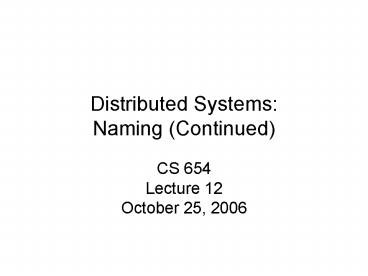Distributed Systems: Naming Continued - PowerPoint PPT Presentation
1 / 26
Title:
Distributed Systems: Naming Continued
Description:
Let's play 'Devil's Advocate' and compare this to ... If very mobile, what can we do to help? ... When a proxy is duplicated, the partial weight is halved. ... – PowerPoint PPT presentation
Number of Views:30
Avg rating:3.0/5.0
Title: Distributed Systems: Naming Continued
1
Distributed SystemsNaming (Continued)
- CS 654Lecture 12October 25, 2006
2
Why Is This Any Better?
- Lets play Devils Advocate and compare this to
straightforward solutions. - Exploits locality
- Search expands in a ring.
- As an entity moves, it usually is a local
operation.
3
Caching
- How effective is caching addresses?
- Depends on degree of mobility.
- If very mobile, what can we do to help?
- If D is the smallest domain that E moves around
in, can cache dir(D). - Called pointer caching.
4
Pointer Caches
- Caching a reference to a directory node of the
lowest-level domain in which an entity will
reside most of the time.
5
Invalidating
- A cache entry that needs to be invalidated
because it returns a nonlocal address, while such
an address is available.
6
Scalability
- Where is the bottleneck here?
- Root has to store everything.
- How to address?
- Federate/distribute the root (multiple roots).
- Each root is responsible for a subset.
- Cluster solution?
- Also distribute geographically.
7
Scalability Issues
- The scalability issues related to uniformly
placing subnodes of a partitioned root node
across the network covered by a location service.
8
Garbage Collection
- How do you handle a server object that is unused?
- Can it be deleted by the server?
- More context.
9
Unreferenced Objects
- An example of a graph representing objects
containing references to each other.
10
Example
- class Class1 Class2 cls2 Class2 global
new Class2foo() Class1 obj new
Class1 obj-gtcls2 new Class2 global
new Class2
11
Reference Counting
- How to avoid the double-counting?
12
Passing a Reference
- Copying a reference to another process and
incrementing the counter too late - A solution.
13
Weighted Reference Counting
- Can we avoid sending increment messages?
2
1
1
2
X
Increment
Decrement
14
Weighted References
- Think of each reference as a token. If you give
each reference multiple tokens, then it can hand
those out without contacting the skeleton.
1
2
1
Step 2 Copy of reference is made. Weight is
divided by two.
2
2
Decrement 1
X
2
Step 1 Reference created with weight 2.
1
Step 3 A reference is deleted. A decrement by 1
message is sent.
15
Weighted References
- Works correctly in the simple case.
2
2
Step 1 Reference created with weight 2.
Decrement 2
2
X
Step 2 A reference is deleted. A decrement by 2
message is sent.
16
Total and Partial Weights
- To work in real situation, the skeleton keeps
track of the initial total weight that is
available. - Each proxy/stub then keeps track of how much
weight it is carrying (the partial weight). - When a proxy is duplicated, the partial weight is
halved. - When a proxy is deleted, a decrement message is
sent.
17
Weighted Reference Counting
- The initial assignment of weights in weighted
reference counting - Weight assignment when creating a new reference.
18
Passing a Weighted Ref Count
- Weight assignment when copying a reference.
19
Indirection
- Creating an indirection when the partial weight
of a reference has reached 1.
20
Generation Reference Counting
- Simple reference counting requires message for
incrementing and a message for decrementing. - Can we somehow combine those into one message?
Maybe delay the increment somehow? - Generation reference counting gets rid of one of
the messages (the increment message). - Basic idea is to try to defer the increment until
we actually decrement.
21
Delayed Incrementing
1
C0
1 A proxy and a skeleton.
X
Increment 2, Decrement 1
1
C2
C0
1
C0
C0
C0
3 First proxy is deleted. It sends a message
saying it created two other proxies, so increment
ref count by two before decrementing by one.
2 Proxy created two more. Ref count at skeleton
is not updated, but first proxy keeps track of
the fact that it created two other proxies (C2).
22
A Problem
1
C0
C2
1 A proxy and a skeleton.
1
C0
C2
Decrement 1
1
X
C0
C0
3 Third proxy is deleted. It has not created any
proxies, so it just sends a message to decrement
by one. This causes the object to be improperly
deleted.
2 Proxy created two more. Ref count at skeleton
is not updated, but first proxy keeps track of
the fact that it created two other proxies (C2).
23
Generations
- Proxies have generations, as in humans.
G0C2
Generation 0
G1C2
G1C1
Generation 1
G2C0
G2C0
G2C0
Generation 2
24
Generational Ref Counting
- Creating and copying a remote reference in
generation reference counting.
25
Deleting a Proxy
- Skeleton maintains a table Gi, which denotes
the references for generation i. - When a proxy is deleted, a message is sent with
the generation number k and the number of copies
c. - Skeleton decrements Gk and increments Gk1 by
c. - Only when table is all 0 is the skeleton deleted.
26
Deleting a Proxy
G01G1-1
G0C0
G0C2
G01
1 A proxy and a skeleton.
G1C0
G0C2
Decrement G1 by 1
G01
X
G1C0
G1C0
3 Third proxy is deleted. It has not created any
proxies, so it just sends a message to decrement
by one. Generation number is different from first
one.
2 Proxy created two more. Ref count at skeleton
is not updated, but first proxy keeps track of
the fact that it created two other proxies (C2).































